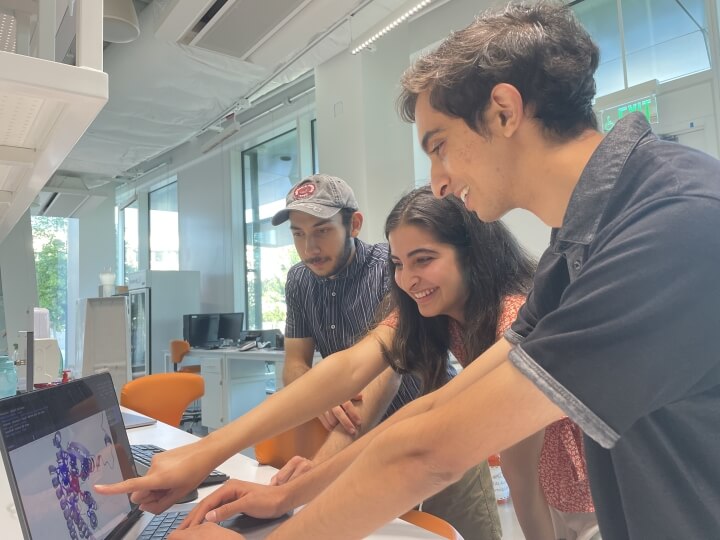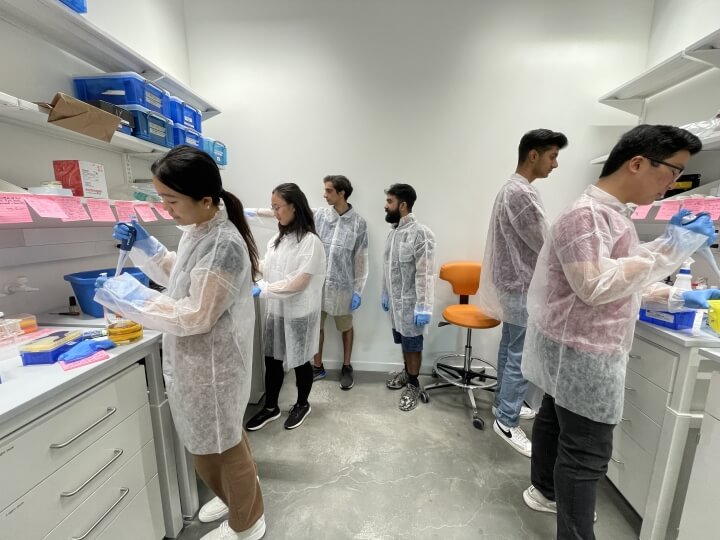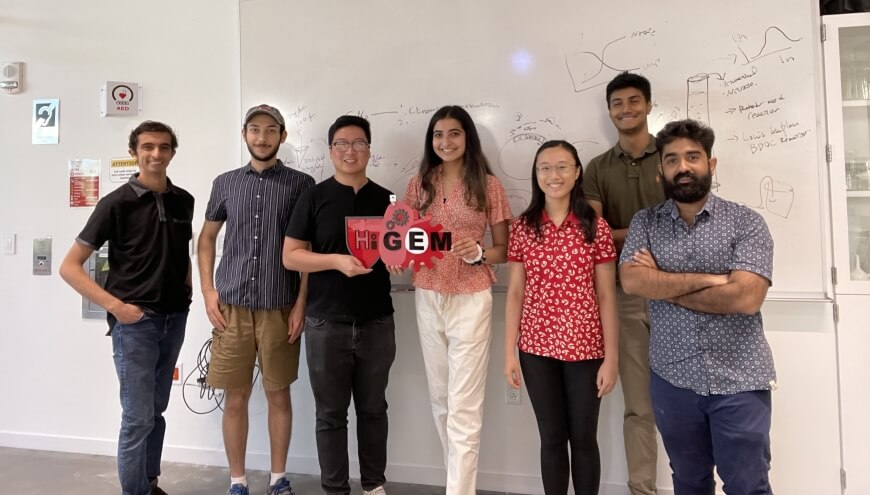News
Harvard iGEM team members Robert Shekoyan, Alvira Tyagi and Arjun Batra analyze a simulation of their computationally designed protein. (Robert Shekoyan)
After arriving at Harvard, Arjun Batra, S.B. ‘25, began looking for ways to get extra laboratory experience. Batra, who plans to concentrate in bioengineering at the Harvard John A. Paulson School of Engineering and Applied Sciences, wanted to integrate his dual interests in hands-on wet lab research and computational science into a single project.
That led him to Harvard’s chapter of the International Genetically Engineered Machine (iGEM), an annual worldwide synthetic biology competition. Batra, along with six Harvard teammates, have spent the last year developing their entry for this year’s competition in Paris in October, where they’ll present a novel way to use computer algorithms to more effectively design proteins capable of analyzing blood for signs of kidney disease.
“The whole learning experience has been absolutely amazing,” Batra said. “We feel like our work is really meaningful and impactful and will really help the field of protein engineering.”
For its competition entry, the Harvard iGEM team looked at proteins called receptors -- long strings of amino acids on the surface of cells shaped in such a way to bind to specific molecules. That binding causes the cells to fluoresce, and measuring that fluorescence can help determine the presence and concentration of the molecule, which is called a biomarker. Using the correct receptor, clinicians can detect the presence of biomarkers associated with diseases.
Designing a receptor that can bond to a specific molecule is often a time-consuming, costly enterprise, as multiple mutations of the amino acids have to be tried before finding the right one.
“The conventional way is just randomly mutating the residues to act as a wide screen to find the ones that work,” Batra said. “We’re trying to be more targeted and direct in our evolution and engineering projects.”
To accomplish this, the Harvard iGEM team designed an algorithm to better predict which amino acid mutations in a yeast protein would be most likely to produce a receptor capable of bonding to cystatin C, a protein associated with kidney disease. By using machine learning, they could reduce the amount of resources needed to engineer the receptors in a lab, hopefully making the process accessible to a wider range of communities around the world.
Harvard iGEM team members conduct wet lab experiments at the Science and Engineering Complex. (Robert Shekoyan)
“We want to use computational tools to cut down on the amount of wet lab time needed and make wet lab protocols significantly faster, more cost-effective, and requiring less time and fewer resources,” said Robert Shekoyan, A.B. ‘23 and student leader for the team. “Generally, the way hospitals screen for kidney disease now is by using either mass spectrometry or aerosol photometry to detect how much cystatin C is in the blood. The problem with all these methods is they require a lot of training for the technicians, and they’re also fairly expensive and not terribly accessible. The benefit of having fluorescence is that you don’t need any training or super-skilled technicians.”
Shekoyan, a human developmental and regenerative biology concentrator at Harvard, is the only member of the iGEM team who isn’t a rising sophomore. Batra, Cody Chou, Aoi Otani, Ani Srinivasan, Alvira Tyagi and Amber Wei all joined during their first year, just as Shekoyan did in fall 2019.
“As rising sophomores, it gives us a lot of scientific independence right off the bat,” Srinivasan said. “We designed this project from scratch, and hopefully at the end we’ll have a really translatable product that we can present. Joining iGEM gave us the opportunity to get this hands-on experience of working with each other in the lab, which has taught us a lot and brought us a lot closer as a team.”
Ph.D. candidate Piyush Nanda was the team’s graduate advisor throughout last year. Nanda is studying biological and biomedical sciences in the lab of Andrew Murray, Herchel Smith Professor of Molecular Genetics, who told him about the undergraduate team’s project.
“Before I joined the team, they had already figured out a really nice plan,” Nanda said. “I just helped them design the experiments and execute them. They came up with a really mature project and an important problem and had a very concrete idea to use computational tools to figure out which mutations should be engineered into the receptors.”
Along with lab experience, iGEM also offers the chance to work with other synthetic biology students and researchers around the globe. The top three projects in iGEM 2021 came from schools in France, Singapore and China and were among more than 350 teams that competed.
Harvard's iGEM team will compete in the International Genetically Engineered Machine worldwide synthetic biology competition later this year. From left: Arjun Batra, Robert Shekoyan, Cody Chou, Alvira Tyagi, Amber Wei, Ani Srinivasan and Piyush Nanda. Not pictured: Aoi Otani. (Robert Shekoyan)
Harvard’s iGEM chapter has a long history of participation in the world. The 2020 team won a gold medal for its viral therapeutic that enhances COVID-19 antibody production, and the 2008 team brought home a gold medal for its development of a bacteria with a controllable electrical output. Other recent iGEM projects include detecting potential heart disease from receptors in the walls of blood vessels and engineering bacteria to prevent excessive buildup of keratin in the skin.
“When we do research in isolated labs at Harvard, you don’t get that international experience of meeting all these like-minded individuals who are as passionate about science as you are,” Tyagi said. “The competition at the end of iGEM draws all these teams together who’ve been working on these really cool biosynthetic research projects.”
The iGEM team met throughout the summer to continue its research and will continue preparing for the Paris competition over the next two months. After that, the team is considering submitting their results for publication in a peer-reviewed journal or expanding the project to explore using the receptors as a drug delivery system.
“This iGEM project provides us with a wonderful opportunity to sit down with researchers and doctors in the field and share ideas about our pipeline and how it would be clinically relevant,” Wei said. “Our project is really tackling a problem not only in the scientific community, but also in medicine.”
Topics: Bioengineering, Computer Science, Student Organizations
Cutting-edge science delivered direct to your inbox.
Join the Harvard SEAS mailing list.
Press Contact
Matt Goisman | mgoisman@g.harvard.edu





